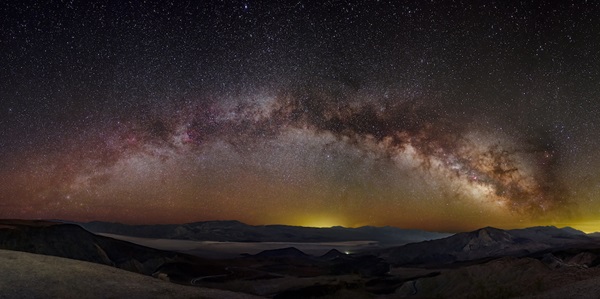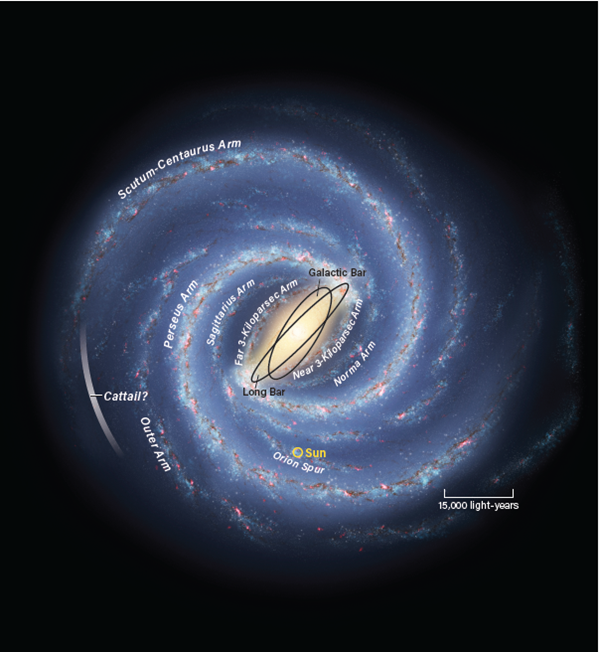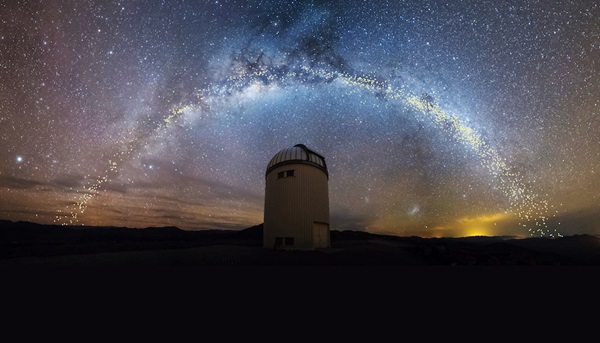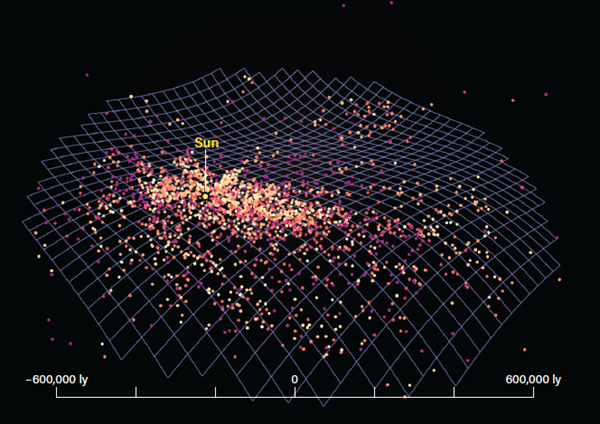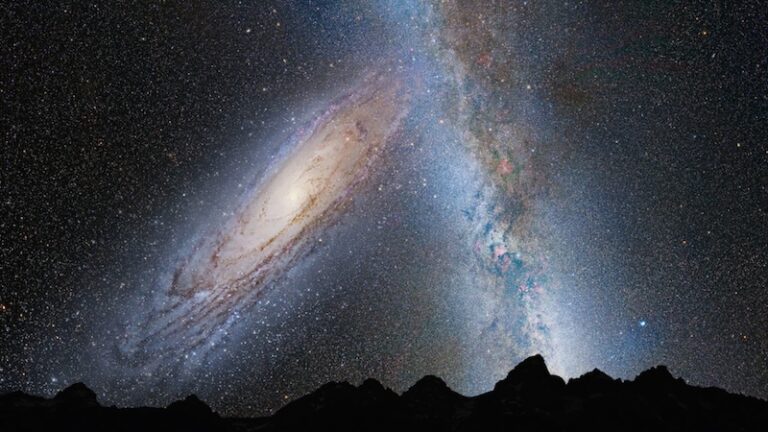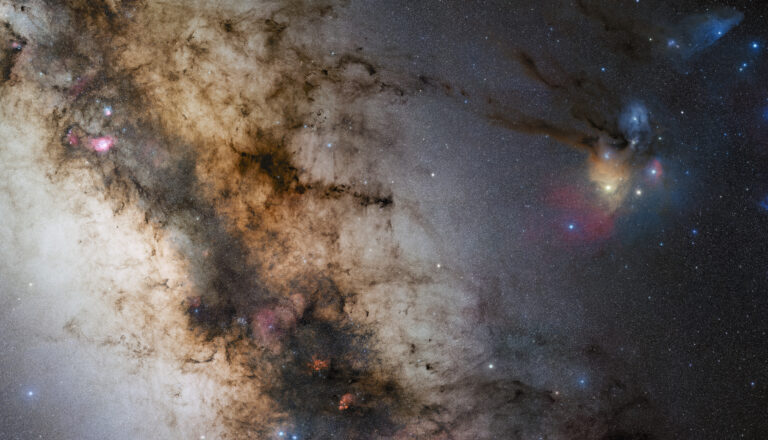Key Takeaways:
- Early understandings of the Milky Way, from mythological interpretations to Aristotle's atmospheric explanation, lacked the technological tools for accurate observation and were superseded by the invention of the telescope.
- The development of telescopes, photography, and spectroscopy, particularly the discovery and application of the period-luminosity relationship of Cepheid variable stars, enabled the measurement of distances to stars and nebulae, significantly advancing the understanding of the Milky Way's scale and structure.
- The "Great Debate" highlighted competing theories regarding the nature of spiral nebulae, ultimately resolved by Hubble's observation of Cepheids in Andromeda, confirming the existence of galaxies beyond the Milky Way.
- The advent of radio astronomy, utilizing the 21-centimeter hydrogen line, allowed astronomers to penetrate obscuring dust clouds, revealing the distribution of gas and a more complete picture of the Milky Way's spiral arms and structure, while also highlighting the mystery of dark matter.
Turn your eyes toward the night sky and you will see a bright, hazy band of light cutting across the sky.
For millennia, observers speculated about the Milky Way’s true nature. The Greeks said the streak of haze in the sky was milk spurting from the breast of the goddess, Hera, Egyptians thought it was cows’ milk, and some Aboriginal Australians thought it was a river flowing through the sky.
Today, we know that we are looking along the plane of our spiral galaxy, consisting of at least 100 billion stars. But understanding the shape of the Milky Way proved elusive up until the 20th century. The problem is we can’t get a bird’s eye view of our galaxy because our solar system is buried within the galaxy. But with the invention of the telescope, photography, spectroscopy, and radio astronomy, we have uncovered the shape and size of our home galaxy — and our place among the billions of stars that make up our island universe.
The telescope revolution
Before the telescope, there was no clear understanding of the extent of our galaxy. Nearly 25 centuries ago, the Greek philosopher Democritus proposed that the Milky Way was filled with stars that appeared to blend together because of their great distance. However, 100 years later, Aristotle suggested that the hazy river of light was an atmospheric phenomenon. Aristotle’s authority was accepted for nearly 2,000 years, until two small pieces of glass finally unseated him.
When Galileo turned his telescope to the sky in 1609, he made astounding discoveries. He published his observations in a little book, Sidereus Nuncius, in March 1610. The Moon was rugged and imperfect, he declared, and Jupiter had four companions. Galileo also scanned the Milky Way and reported, “This spyglass has allowed me to discover a multitude of fixed stars never before seen, of which there are more than ten times as many as are naturally visible.”
Observing targets like the Orion Nebula (M42) and the Beehive Cluster (M44) in the constellation Cancer, Galileo found myriad stars unobservable to the naked eye. He thought all the fuzzy objects in the sky would be resolved into stars; the astronomer could not know that each would play a role in giving us a picture of our galaxy.
Spiral nebulae
After achieving overnight fame in 1781 when he discovered Uranus, William Herschel was swiftly appointed as King George III’s court astronomer. The king gave him money to build telescopes, including his 40-foot-long (12 meters) telescope with a 48-inch mirror.
With it, Herschel produced perhaps the first systematic map of the Milky Way. He started by observing a dense area of the Milky Way and counting the number of stars in his field of view. As he moved away from the plane of the Milky Way, the number of stars dropped.
Herschel assumed that the number of stars in each area was a direct indication of the stellar population in that direction. Unaware of any relationship between faintness and distance, or that millions of faint stars were obscured from his view, he produced a diagram of the Milky Way that looks like a gigantic amoeba!
By the 1840s, Herschel’s equipment was dwarfed by the Leviathan of Parsonstown in Ireland. Built for William Parsons, Earl of Rosse, this monstrous telescope’s 72-inch mirror allowed Rosse to produce amazingly detailed drawings of what he saw. In particular, his observations of the Whirlpool Galaxy (M51), the Triangulum Galaxy (M33), and M99 (NGC 4254) showed distinct spiral structures. Without a proper way to measure distances, astronomers could only question whether these nebulae, like stars and clusters, were within the Milky Way. After all, if they were distant structures beyond the Milky Way, what did that mean for our place in the universe?
Cosmic yardsticks
The debate about the physical nature of the Milky Way continued into the early 20th century. Two new technologies helped charge the discussion: spectroscopy and photography. The ability to analyze starlight gave astronomers a powerful new way of understanding the chemistry of stars, while photography augmented the limited light-gathering ability of the human eye.
Armed with these tools, astronomers Henrietta Leavitt, Edward C. Pickering, and Ejnar Hertzsprung discovered and defined a relationship between the period of dimming and brightening of a class of stars called Cepheid variables. In 1908, Leavitt was studying variable stars in photographs of the Large and Small Magellanic Clouds sent to the Harvard College Observatory, where she worked, from Harvard’s observatory in Peru. She noticed a rhythmic and predictable variation in brightness of these stars in the Large and Small Magellanic Clouds, which might last from a single day to more than a month before repeating.
Furthermore, she discovered, the longer the period of variation, the brighter the star appeared to be. Since all the stars in the Small Magellanic Cloud are at roughly the same distance, she reasoned that the period of a Cepheid variable was related to its true, intrinsic brightness.
Pickering, the observatory director, suggested this period-luminosity relation could be useful to determine the distribution of star clusters and nebulae. And Hertzsprung was able to calibrate this technique by making independent distance measurements to Cepheids using the parallax method, seeing how much they shifted against background stars as Earth orbited the Sun.
Thus, by measuring the period of a Cepheid, astronomers could know its true brightness — and by comparing that to its apparent brightness, calculate how far away it was. Astronomers finally had a reliable cosmic yardstick.
Around the same time, the young astronomer Harlow Shapley began measuring the distribution of globular clusters — compact and dense spheres of stars. By 1918, he had found that the clusters centered around the constellation Sagittarius, forming a halo around the Milky Way. He also made improved parallax measurements of Cepheid variables, which in turn improved the calibration of Leavitt’s relation.
Using this data, Shapley not only located the center of our galaxy — in Sagittarius — but also showed that the Milky Way was 10 times the size of previous estimates. His observations also placed our solar system far from the center of the galaxy. Given the size of our galaxy, Shapley was convinced that spiral nebulae, like globular clusters, were all part of the Milky Way.
The Great Debate
By the early 20th century, speculation about spiral nebulae and the nature of the Milky Way had reached a fever pitch. Photography clearly showed these nebulae had well-defined spiral structure composed of countless stars, but there were no good measurements of their distance to verify whether they were within the Milky Way or not.
In April 1920, Harlow Shapley faced off with Heber Curtis at the National Museum of Natural History in Washington, D.C., in a discussion called the Great Debate. Shapley maintained that spiral and all other nebulae were part of the Milky Way, just like globular clusters. But Curtis provided convincing evidence that they were independent star systems — “island universes,” as he called them, a term coined by the German philosopher Immanuel Kant.
Cepheid variables ultimately settled the debate. A few years later, while using the 100-inch Hooker telescope at Mount Wilson Observatory in California, Edwin Hubble found Cepheid variables in the Andromeda spiral nebula. Using Shapley’s calibration of Leavitt’s period-luminosity relation, Hubble showed this object was 900,000 light-years away, far beyond the outskirts of Milky Way. (This figure has since been refined to 2.5 million light-years.) In a single measurement, he proved that the Milky Way was not the entire universe, but part of a vast sea of island universes.
Radio astronomy rises
In the 19th century, astronomers were puzzled by large areas along the Milky Way almost devoid of stars. These so-called coal sacks appeared as dark holes against a starry background. At least one astronomer speculated they might be openings into heaven!
Because at that time the exploration of the Milky Way was still restricted to visible light, astronomers were unaware that the coal sacks were huge clouds of gas and dust blocking the light of distant stars. New technology would need to be developed before astronomers could explore and understand these cold, dark clouds running throughout the plane of the Milky Way.
The birth of radio astronomy provided this new tool and led to the discovery that the galaxy is filled not only with dust, but also with tremendous amounts of cold, neutral hydrogen gas. Most of the time, a hydrogen atom’s proton and electron spin in the same direction. But sometimes, electrons flip and spin in the other direction. For any given hydrogen atom, this only happens about once every 100 million years. When it does, energy is emitted with a wavelength of 21 centimeters. These waves pass right through the clouds of dust that hide visible light, which has a much shorter wavelength.
When astronomers first detected 21 cm radiation in 1951, they began using it to finally peer through these clouds to build a fuller picture of our Milky Way. By noting the distribution of neutral hydrogen, astronomers could map unseen portions of the galaxy, tracing its spiral arms, where hydrogen is concentrated.
The shape of our galaxy
Over the past 70 years, a picture has emerged of a massive galaxy with four primary spiral arms. The Sun is located 27,000 light-years from the galactic center along the Orion Spur, a smaller arm located between the Perseus and Sagittarius arms. In recent years, astronomers have discovered our galaxy’s central bulge has a bar structure. And its disk of gas and stars is slightly warped and twisted, perhaps by gravitational interaction with nearby dwarf galaxies.
There are deeper mysteries yet to be resolved. For instance, Newton’s law of gravity holds that stars and gas at a galaxy’s outer fringes should orbit slower than objects closer to its center — but instead, we observe that outer objects move faster. This is true in our galaxy, as well as others. The only explanation — without modifying the law of gravity — is the unseen existence of a great deal more mass, probably in the form of dark matter. But this dark matter has never been directly observed.
To stand out under a dome of shining stars and understand their true nature is an amazing feat of human ingenuity. To fathom the immensity of our galaxy and our place in it is a striking act of human imagination. Democritus envisioned vast numbers of stars beyond his power to see. And thanks to countless astronomers who came after him, we have found our true place in the galaxy we call home.

